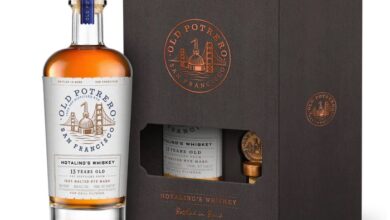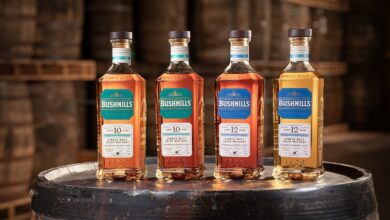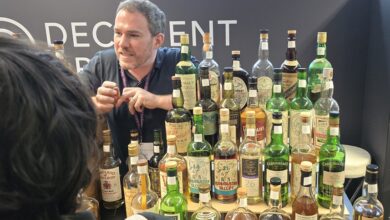Q&A With Rob Dietrich, Stranahan’s Master Distiller
By Kurt Maitland

(Credit: Kurt Maitland)
Back in late June I had the pleasure of traveling to Denver, Colorado to attend Stranahan’s Cask Thief Festival at their distillery. The festival, now passed its third year, and is an event that shows off the best of Stranahan’s. Fans come from all over to see the distillery, eat, listen to music and, last but certainly not least, to get a taste of their rarest barrels. Each year, these barrels are selected by Stranahan’s Master Distiller, who I have the pleasure of speaking to about his work.
KM: Can you tell our readers about yourself and how you got into making whiskey?
RD: Sure. I’m the Master Distiller of Stranahan’s Rocky Mountain Single Malt Whiskey. I joined Stranahan’s in 2006, when I met the founder Jess Graber and he hired me on to work the 1 am to 9 am night shift, and earned the reputation as the original “Night Ninja.” I had met and bonded with the original head distiller * over our mutual passion for vintage motorcycles and alternative fuel, and started out working the bottling line. At the time, a friend and I had worked together to build a diesel motorcycle out of a diesel engine from a cement mixer and a Czech motorcycle frame, and we ran it on vegetable oil. Total rat bike and a lot of fun!
Before I joined Stranahan’s, I spent roughly 10 years in the music business, starting with Bill Graham Presents and working as a freelance agent for venues like Red Rocks Amphitheatre and The Fillmore Auditorium, as well as touring with international musical acts. Prior to that, I was a soldier in the U.S. Army’s 10th Mountain Division and served in two combat tours in Somalia and relief operations in Haiti.
I’ve worn a lot of different hats at Stranahan’s over the years and as the Master Distiller, I now oversee every aspect of our “grain-to-bottle” production, from sourcing our malted barley from the Rocky Mountain region, distilling, barrel aging and marrying our barrels to bottling batches at the distillery.
Once a year, I get to be a little creative with the Stranahan’s Snowflake cask-finished whiskey, which is where I get to color outside the lines and make some whiskey art. I create each batch by nose and taste, and marry a variety of cask-finishes together to make a one-of-a-kind whiskey that we only release one day a year at the distillery.
KM: For you, what are the strengths of Stranahan’s working with a single malt distilling process versus what has been standard in American craft whiskey?
RD: When we started Stranahan’s Whiskey **, we set out to make a whiskey that we wanted to drink and make it well. At the time, we didn’t want to compete with the big, well-established distilleries by producing a whiskey that was [like what was] already mass-produced. We’re a little outlaw here in Colorado, so that’s why we created our own version of American Single Malt whiskey to help us stand apart. By focusing on making one type of whiskey and fine-tuning the process to make that whiskey as high-quality as possible, that gave us the focus and strength to stand alone in a very competitive market.
KM: We first met in New York during a discussion about The American Single Malt Whiskey Commission (ASMWC). Can you tell our readers more about the ASMWC and your role in it?
RD: Stranahan’s is a member of the American Single Malt Whiskey Commission and, alongside other ASM producers, we’ve lobbied with the TTB for our category to be recognized not only on a national scale, but also on a global one. At the moment we are still waiting on a decision from the Federal government as to whether or not they will officially recognize us as an American Single Malt Whiskey and create a new category. In the meantime, we continue our stance to provide a strong argument to establish an identity by region, just as globally recognized categories are. Our job as American Single Malt producers is to keep educating the consumer and spirits trade on the importance of establishing an American Single Malt category.
In the TTB spirits regulations, there are categories listing every kind of spirit recognized in America. Under the ‘Whiskey’ category, there are 41 ‘Types’ of whiskey — including single malt — however, there is not a type for ‘American single malt’. ‘Japanese single malt’ is listed as type, as is ‘Scotch’, etc. which identifies single malts by country. Our ultimate goal is be identified as an ‘American single malt’ so we are able to be recognized in the global market.
KM: I recently had the pleasure of hanging out with you at Stranahan’s yearly Cask Thief festival. One can’t help but notice how much you are into wine. Have you always been into vino and how does it influence what you do with the Cask Thief and Snowflake releases?
RD: I got into wine in my punk rock years, as one of my best friends at the time had a father who was a wine enthusiast and had an amply stocked wine closet. My friend found a way to break into the cache o’ wine and would occasionally snag a bottle or two and wax poetic about the different varietals as we listened to punk music on vinyl, thus beginning both my education in wine and appreciation for obscure music. Years later I would continue that passion by traveling to different wine regions via motorcycle, my favorite being a motorcycle trek across Argentina from Buenos Ares to Mendoza to enjoy a fantastic Malbec and a steak, then turn around and ride back. Epic trip!
KM: Can you tell us more about the process used to create the Cask Thief and Snowflake releases?
RD: Snowflake started out in 2007 as a cask-finishing project by Jess Graber, the founder of Stranahan’s Colorado Whiskey. The first three Snowflakes were actually released at the same time, each an individual barrel of roughly 280 bottles each. One was a Port barrel cask-finish, another Hungarian white oak and the 3rd was Cabernet Franc, bottled separately. They sat on the shelf for a while, and only sold at our tasting room at the distillery. Each year we started cask-finishing in unique barrels, and releasing only one barrel at a time.
In 2011, I started blending in-house cask-finished barrels to create unique and interesting profiles by nose and taste and it took off like a cult film. People were lining up the day of the release, and over time, people started lining up earlier and earlier to purchase a limit of two bottles. This last year, the first people got in line on Wednesday for a Saturday morning release, and there were around 1,000 people camped out around the building in the December cold.
When I create a Snowflake batch, I will take samples from each of the cask-finishes and create several different batches by nose and taste and then narrow them down to the one that completely blows me away. For example, I might take 1 part Tempranillo, 2 parts Cognac, 1 part Malbec, and create that as a batch. Or 2 parts Madeira, 3 parts Sherry, 1 part Sangiovese and that would be a batch, and so on. I might build a dozen or more batch samples and then over a period of several weeks, narrow it down to the batch I think is the best to release that year.
Cask Thief came about from a desire to share a bit of the Snowflake process with our fans and let them taste the cask-strength whiskey directly from the barrel. I select six different barrels based on their individual uniqueness and flavor profile, and we use a specially made copper rod called a ‘thief’ to pull the whiskey from the barrel and straight into your glass. Each attendee gets a glass and a passport that outlines each barrel by name and description.
This year for our third annual Cask Thief event, we had two live bands and smoked a half dozen pigs from Black Belly catering with Stranahan’s whiskey barrel staves for our outdoor dinner entrée. We also featured a local ice cream company called Sweet Action, which provided some amazing Stranahan’s Whiskey Brickle Ice Cream. Representatives from the cooperage that crafts our barrels—Independent Stave Company–did a couple of live presentations on tuning a barrel and rebuilding them. All in all, a fun day and this last year was definitely our largest turnout yet.
KM – Do you have wines that you feel from personal experience are best to finish Stranahan’s in? Are there any wines that you are interested in using but haven’t had a chance to as of yet?
RD: I absolutely love Malbecs and Pinot Noirs and have been enjoying chilled white wine in the heat of the Colorado summer, mostly Pinot Grigio, and try to locate barrels that house fantastic wines to cask finish our aged Stranahan’s whiskey. I had a great cask finish from a Sangiovese barrel that was pretty mind blowing and want to keep innovating by seeking out unusual, but tasty barrels to throw in the mix. I haven’t used a Pinot Noir yet, so I’d say that is definitely on the list for a future cask finish. I’ve also used rum, cognac, port, etc. and eventually would like to see what a tequila barrel might bring to the game.
KM: You have been part of Stranahan’s for a long time now. What has surprised you most about its growth and success?
RD: I truly feel that I have the greatest job on the planet. I get to make whiskey, drink whiskey, and talk about whiskey all over the country and the world.
It’s been an amazing ride, to see the whiskey community grow and to be one of the leading craft distilleries to help lead the charge has been truly an honor. In the early days people weren’t used to craft spirits, so they were always a little suspicious to try a new whiskey that didn’t come from the larger producers. Now people are very used to craft and are willing to step outside their usual comfort zone to try new whiskies and really narrow down what they love. Throughout the years, trying to explain what our single malt is to consumers has been a little interesting because the first thing a lot of people would say after I told they were drinking a single malt is “Oh, so you’re making a Scotch!” and I would answer, “Nope, we make our single malt whiskey from grain to bottle in Denver, Colorado, so we are an American Single Malt.”
The growth of where we came from with just three of us making whiskey around the clock in the early days, to now, where we have a StranaFam of about 40 people (that includes a large number of part time tour and gift shop staff) has been pretty incredible to be a part of. We have such an amazing team at the distillery and we truly couldn’t produce such a great whiskey if it wasn’t for the passion and hard work of each and every one of them.
A lot of our success is really how passionate the fans of our whiskey are, and how much they are a part of our whiskey community. I’m always impressed and amazed at the lengths our fans go through to get their hands on a bottle of our whiskey, especially the limited release batches. As long as the StranaFans keep enjoying our whiskey the same way we do, we’ll keep making it! It just might require a little patience; whiskey is all about the long game, especially in the craft world.
* Their first Master Distiller, Jake Norris, left in 2011 to work for Laws Whiskey House. He subsequently left that distiller in 2016 and is currently working as a consultant.
** Stranahan’s was an forerunner of the modern craft whiskey movement, with its first whiskey distilled in 2004.



